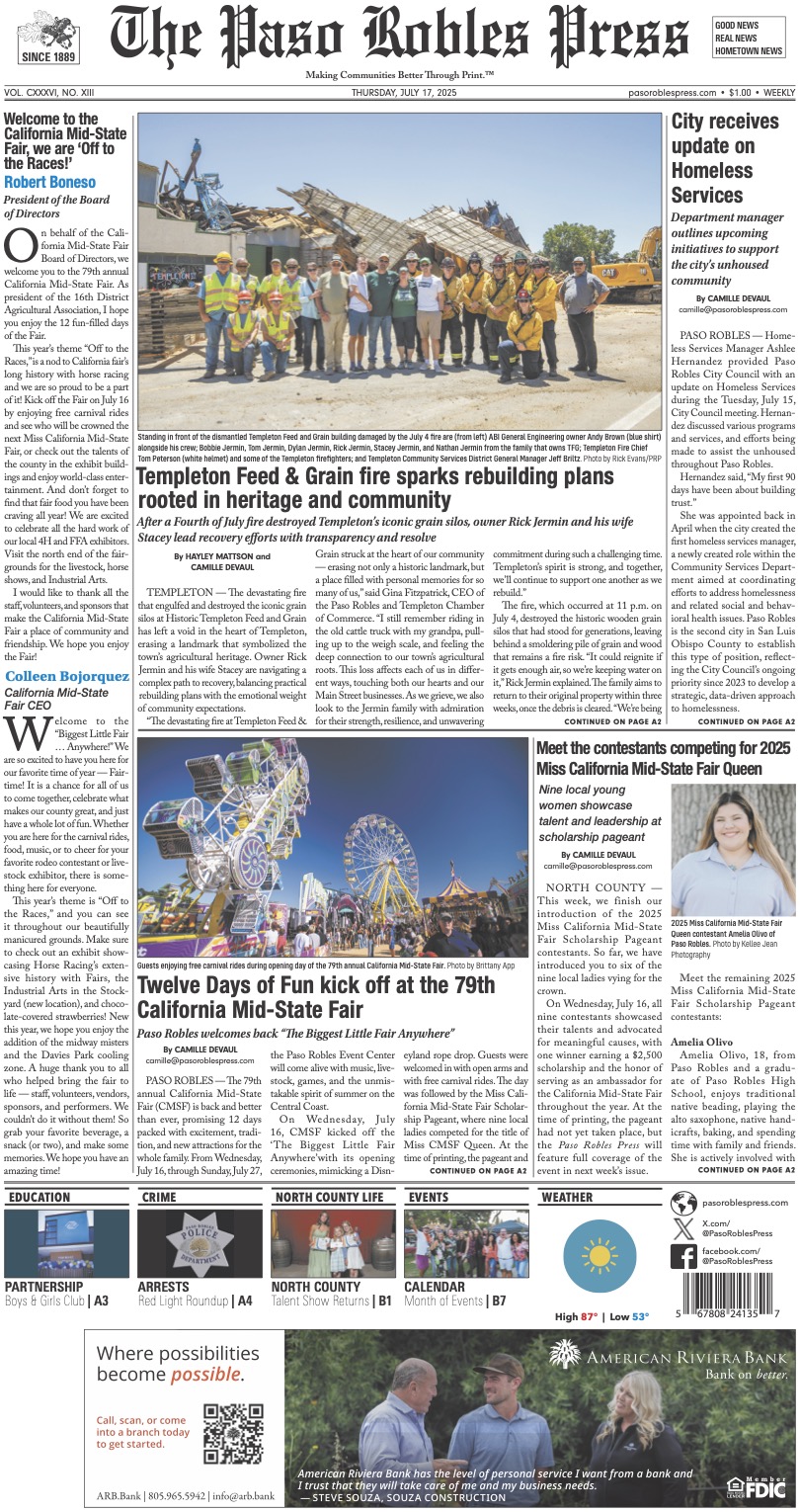The City of Paso Robles Community Development Department recently confirmed the status of the next seven hotel projects that have been approved for expansion and construction, including two Downtown structures and an RV resort.
“The City has seen a dramatic increase in hotels and lodging. Within the next 12 months, we expect to see 200 more hotel rooms and another 600 rooms within the next two to three years,” said Community Development Director Warren Frace, who is responsible for overseeing the City’s Planning, Engineering and Building Divisions.
Here’s a look at what’s in the pipeline at City of Paso Robles. Frace reported that four new lodging accommodations are expected to open by Fiscal Year 2018-19, including 187 rooms and 332 RV spaces. They include:
- Oxford Suites Hotel, a five-story, 69,209-square-foot project with 127 rooms at 4th and Pine Street
- The Piccolo at Paso Robles Inn, a four-story, 17,946-square-foot brick façade structure with 23 rooms.
- Cava Robles RV Resort, a 12,000-square-foot RV park with 332 spaces on Golden Hill RoadLone Oak Hotel conversion of 37 rooms located at 715 24th Street
By Fiscal Year 2019-20, the City foresees completion of another 418 rooms:

Marriott Residence Inn
- Hotel Cheval (Phase 2), a new two-story, 20-room structure across from the existing Hotel Cheval on the northeast corner of Pine and 10th Street
- Marriott Residence Inn, a four-
story project with 128 rooms - Fairfield Inn, a 119-room development
- Hotel Ava, a four-story, 155-room hotel with restaurant and retail at 944 Pine Street (previous Hayward Lumber 2.42-acre parcel)
Transient Occupancy Tax funds
On August 2, 2017, the City of Paso Robles hosted an Emergency Services Community Workshop aimed at assessing the current level of fire and emergency first-response services in the city and to consider strategic, long-term planning. At the well-attended gathering, questions were raised about the effects of fire services relative to hotel construction.
Implemented at the rate of 10 percent, the City’s Transient Occupancy Tax (TOT) yields $4 million annually for an existing 1,413 rooms. Deposited into the General Fund, these monies help support the City’s annual operating budget, including emergency services funding, which benefit both new and existing structures throughout the community.
Mayor Steve Martin also pointed out that TOT’s help to subsidize emergency services, albeit with some limitation. The average property tax the City receives from single-family residences is $1,100 annually. For hotels, the cost is $450 per room.
As for the strain on emergency services, City consultant Stu Gary explained that modern building codes and materials,
such as sprinklers and fire walls, help to effectively mitigate danger, but underscored that state law requires certificated testing every five years. He added that, by nature, new hotel structures have more safeguards in place than older residences.
Impact on water
A common worry for many Paso Robles property owners is water scarcity and California’s ongoing battle with chronic drought.
“The City has a long-term Urban Water Management plan that was adopted in 2015 that covers all existing and proposed future development, including hotels,” confirmed Warren Frace.
To help address the issue, the City established conservation measures, including seasonal water restrictions, graywater harvesting guidelines, a Landscape and Irrigation Guide, and a Water Efficient Landscape Ordinance with a “Landscape Documentation Package must be presented with or prior to the submittal of construction drawings for building plan check. A Conservation Element is part of the General Plan with action items for water sourcing, supply and distribution, including provisions and conservation programs for
residents and business.
In addition, the City began offering rebates to homeowners or businesses who replace irrigated lawns with drought-tolerant plants on drip irrigation, artificial turf, or permeable paving, provided that specific landscaping requirements are met. High-efficiency toilet rebates of up to $125 for residents and businesses are also available.
What is important to note with new hotel construction and expansion projects is that they are required to use low-flow fixtures, water-efficient appliances, drought-tolerant landscaping and other water conservation practices.
In related construction news, on May 15, Paso Robles City Council reviewed the EIR consultant contract for the Beechwood Specific Plan, located on Creston Road, just north of Franklin Hot Springs. The conceptual neighborhood was presented before the Planning Commission for 915 single- and multifamily residences (since decreased from 1,011), mixed use commercial development, open-space areas, parks, and multipurpose trails within a 236-acre parcel bordered by Meadowlark Road, Creston Road and Beechwood Drive in the southeast section of the city.
Matt McLish, Executive Committee Chairman of Paso Robles Chamber of Commerce, who attended the Open House for the Beechwood Specific Plan on April 11 concluded, “The feedback was good, and the project seems to be intelligently thought out with a good plan for water.”
Growth: Past, present and future
In 2010, the population of Paso Robles was 29,785. Slow, steady growth increased that number by 2,122 by 2016, when the population was recorded at 31,907. But those who have watched the city’s population expand in recent years may be surprised to learn that the most significant growth in Paso Robles actually occurred decades ago.
Not only did Paso Robles weather the early recession of the 1980-1982, when nationwide bankruptcies rose 50 percent and agricultural exports declined, but the City saw its population more than double from 9,200 to 18,600 between 1980-1990, according to the U.S. Census and State Department of Finance. By Y2K, the community’s population began to reflect a strong, steady
decrease in population growth. However, by the end of the first decade, during the nation’s Great Recession, the population dropped to zero growth. Then, through 2014, the population alternately decreased and increased annually within one percent.
Despite these economic ups and downs, the Downtown core has flourished with restaurants, wine tasting rooms, shops and offices. Courtesy of local support, business is brisk, in large part by tourist dollar support.
Matt Masia, whose family has been in the hotel business since 1961, operates the Adelaide Inn and the neighboring Best Western Plus Black Oak property in the 24th Street corridor across from the Paso Robles Event Center. Still in process at the Planning Department is Black Oak Lodge, a four-story, 96-room, 59,229-square-foot hotel on a 1.8-acre lot at 2717 Black Oak Drive, adjacent to the 24th Street McDonald’s restaurant. Masia confirmed that when he breaks ground, local contractors will be hired to launch the project.
“Everyone is looking toward the future, but I think each one will depend upon the process of approval, financing and time,”
Masia said matter-of-factly. “It takes years to get hotels built and economic forces have a lot to do with that in the business of supply and demand.” He also observed that other hotel properties with room rates in the high tier tend to drive down prices of more moderately priced hotels, including his own, to remain competitive.
“In the summer, we’re easily 100 percent full,” said Masia, “and we average around 50 percent in the winter. But what often gets overlooked is business lodging throughout the week. We have 4H and FFA families who stay, military personnel, wine-related sales professionals and others, oil rig workers, and truckers. “We easily get 10 truckers a night needing lodging. Monday through Thursday we’re 75 percent full on average.”
Chamber Chairman Matt McLish, who also serves as a Paso Robles School District Board Trustee, pointed out that when visitors come to Paso, it takes two days to generate the type of revenue from food, lodging and sales tax that a resident typically generates in a month. “We also have military bases nearby that depend upon Paso Robles hotels when they arrive for exercises in our area – Vandenberg AFB, Camp Roberts, Fort Hunter Liggett, plus travelers from Lemoore, who prefer Paso Robles over King City,” he said.
“On average, year-round, our hotels are about 74 percent full. The taxes generated are revenue for road building that comes largely through tourism. I’d be scared to think of what we’d be looking at without it,” said McLish. He added that in addition to the service jobs that hotels provide, he hopes to see a more diverse mix of industry, including “ag tech, which is our strength.”
Executive Director Norma Moye at Paso Robles Main Street Association has observed changes in Paso Robles for decades. A Paso Robles High alumnus, Norma is considered among the core contingent of Paso Robles historians who are deeply involved in hands-and-feet service to the community. Norma shared her perspective about the renewed building and expansion efforts throughout the city.
“I think it’s wonderful; it’s progress,” said Norma. “We’re (Paso Robles) a destination. It’s a great Downtown now. It’s walkable and that’s neat. We’ve got good people who work here and make it a great place to live. We’re a can-do people who all work together.”
When asked about the concerns some people express about the town increasing the number of hotel rooms, Norma said, “We can’t stop growth, for Pete’s sake. We can’t just shut the door, and we didn’t when people moved here who are now saying they don’t want any more to come in. TOT brings events and helps our quality of life here. We draw tourism, which is great, and they visit and leave. We could use more parking lots. Maybe we can build a (mixed use) parking garage and put retail on the bottom floor,” she theorized. “But think about it. Have those dollars ruined the Downtown? Nope. Look at it now!”
A 10-year resident of Paso Robles, Chamber chairman McLish grew up in Orange County, and shared his perspective about big-
influence into North County. In his Chamber capacity, McLish said that, like anyone who has adopted Paso Robles as their town, he foresees more transplants arriving to do business that share a common mindset with Paso natives to keep everything in balance. People who have moved into Paso Robles to get away from the sprawl of large-city populations, he said, share the same concerns of those who grew up in North County.
“I feel pretty confident that these folks know what positive growth is,” said McLish. “In Orange County, sometimes I didn’t know what community I was in because there was no delineation from one community to another. My parents live in
Orcutt now and they visit. We enjoy the seasonal activities here, like Halloween and the tree lighting at the park, and I enjoy watching them with Eli, our four-year-old. We had wall-to-wall commerce and residential in Orange County with a disregard for aesthetics. They lost that at some point,” said McLish.
“Everyone I’ve been involved with here at the City is very concerned for retaining Paso history and the quality of life with a small-town feel.”
Mayor Steve Martin reported recently that in Fiscal Year 2017-18, the top revenue generators for the City were property taxes, sales taxes and TOT revenue, which only underscores the need for tourist dollars, essential funds that keep the wheels turning on the City’s economic bus. The view from that bus isn’t bad, either, according to a recent City survey conducted amongst residents. Mayor Martin reported that of 466 people who replied, 92 percent reported quality of life in Paso Robles as “good” or “excellent.”
“Tourism generates a tremendous amount of tax revenue and it’s a trade-off,” Community Development Director Frace said of the ebb and flow of people that tourism brings into the community. “The more that tourists come to spend money here, the more
they help pay for our city’s infrastructure.”
Melissa Chavez can be reached at melissa@pasomagazine.com













